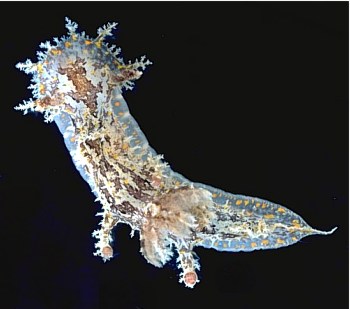
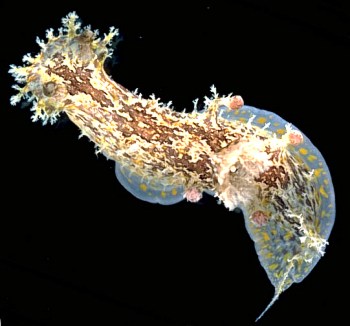
Plocamopherus ceylonicus
(Kelaart, 1858)
Order: NUDIBRANCHIA
Suborder: DORIDINA
Superfamily: ANADORIDOIDEA
Family: Polyceridae
Subfamily: Triophinae
DISTRIBUTION
Tropical Indo-West Pacific.
PHOTO
UPPER: Angourie, North Coast of New South Wales, March 1982. C132967
LOWER: Solitary Islands, Coffs Harbour region, New South Wales, C155708, March 1988.
PHOTOS: Bill Rudman.
Brown patches and speckling with orange-yellow spots around the edge of the foot and on the mantle. The four papillae surrounding the gills are tipped by a large rounded pinkish knob which flashes light when disturbed. It is not known how this luminescence occurs. The posterior tip of the foot extends into a long tapering 'tail'.
References:
• Kelaart, E.F. (1858). Description of a new Ceylonese nudibranch. Annals and Magazine of Natural History, series 3, 1(4): 257-258
• Rudman, W.B. & Darvell, B.W. (1990). Opisthobranch molluscs of Hong Kong: part 1. Goniodorididae, Onchidorididae, Triophidae, Gymnodorididae, Chromodorididae (Nudibranchia). Asian Marine Biology, 7: 31-79
Rudman, W.B., 2000 (March 27) Plocamopherus ceylonicus (Kelaart, 1858). [In] Sea Slug Forum. Australian Museum, Sydney. Available from http://www.seaslugforum.net/find/plocceyl
Related messages
Re: Plocamopherus ceylonicus from Ratnagiri, India
November 4, 2009
From: Vishal Bhave
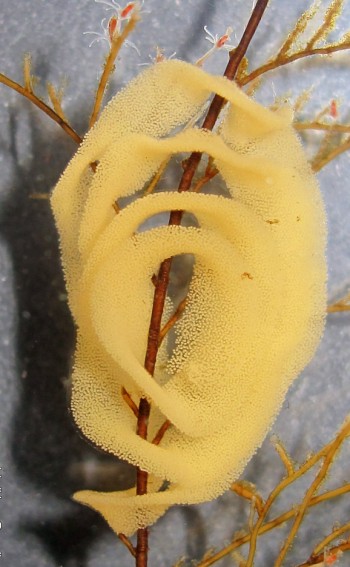
Concerning message #22707:
Egg case of same specimen
Locality: Ratnagiri, Maharashtra, India, Arabian sea, 20 October 2009, In captivity . Photographer: Vishal Bhave.
Vishal Bhave
vishalbhave@gmail.com
Bhave, V.J, 2009 (Nov 4) Re: Plocamopherus ceylonicus from Ratnagiri, India. [Message in] Sea Slug Forum. Australian Museum, Sydney. Available from http://www.seaslugforum.net/find/22742Dear Vishal,
Thanks. It is interesting to see the egg ribbon laid on a hydroid colony as Plocamopherus feeds on bryozoans. Presumably it does not feel the stinging cells [nematocysts] of the hydroid polyps when it is laying the egg ribbon.
Best wishes,
Bill Rudman
Plocamopherus ceylonicus from Ratnagiri, India
October 26, 2009
From: Vishal Bhave
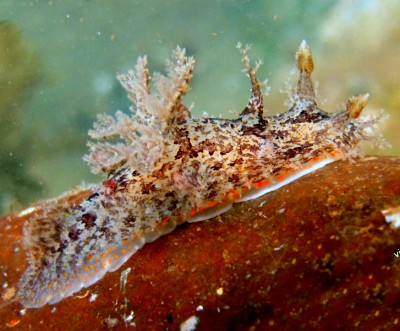
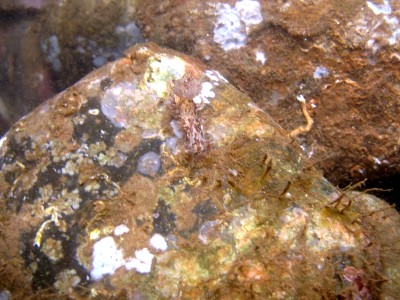
Concerning message #22507:
Last time I submitted juvenile. This time in survey I got possibly adult (?)
2 specimens were seen
Locality: Mandavi, Ratnagiri, 5 centimeters, Maharashtra, India, Arabian sea, 15 October 2009, Intertidal, beneath the rock, in rockpool. Length: 35 mm. Photographer: Vishal Bhave.
Vishal Bhave
vishalbhave@gmail.com
Bhave, V.J., 2009 (Oct 26) Plocamopherus ceylonicus from Ratnagiri, India. [Message in] Sea Slug Forum. Australian Museum, Sydney. Available from http://www.seaslugforum.net/find/22707
Dear Vishal,
Thanks for these photos. They are certainly mature specimens of Plocamopherus ceylonicus. It's good to get photos of specimens from near the type locality... or at least much closer than the west Pacific, where it has usually been reported from.
Best wishes,
Bill Rudman
Plocamopherus ceylonicus ? from Ratnagiri, India
June 1, 2009
From: Vishal Bhave
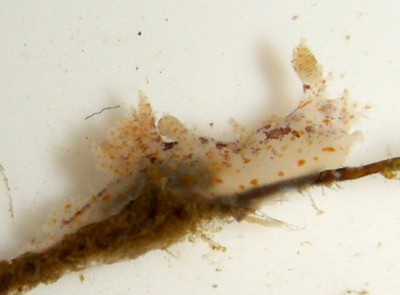
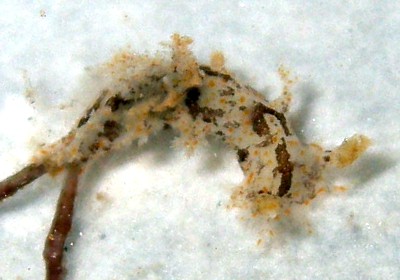
Concerning message #20584:
Found at low tide, Below rock in area of loose rocks. I have kept it alive to observe Luminescence, till today nothing was observed, maybe due to small size I can't observe that?
Locality: Rock patch, Mandavi, Ratnagiri , 0.5 feet, Maharashtra, India, Arabian sea , 27 May 2009, Intertidal, sandy with many small, loose rocks. Length: 8 mm. Photographer: Vishal Bhave.
Vishal Bhave
vishalbhave@gmail.com
Bhave, V.J., 2009 (Jun 1) Plocamopherus ceylonicus ? from Ratnagiri, India. [Message in] Sea Slug Forum. Australian Museum, Sydney. Available from http://www.seaslugforum.net/find/22507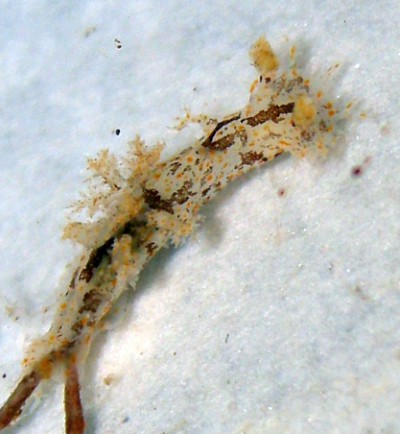
Dear Vishal,
Thanks for these nice photos of an Indian Plocamopherus. I have always considered this species, with a dark brown symmetrical pattern and orange or yellow spots, to be Kelaart's Plocamopherus ceylonicus. As you can see on the Forum there is quite a colour variation but usually some sign of the spots and the dark brown pattern. When I saw your animal I thought I would compare it with the early paintings of Kelaart from Ceylon [message #2170] and Alder & Hancock from India [message #2171] that I have already posted on the Forum.
To my surprise these paintings have more in common to Valles & Gosliner's P. maculapodium which has been recently discussed on the Forum message #22501], than to the species I have identified as P. ceylonicus. In the paintings we can clearly see dark spots along the edge of the foot and a quick look at Kelaart's description showed he described his Polycera? zeylanica as: "Colour above bright orange-red, beneath whitish, with red specks seen through the transparent foot".
Unfortunately, Valles & Gosliner do not include P. ceylonicus in their review of the genus so I can't comment on their reasons for proposing the new species P. maculapodium. Two other new species in their paper, P. lemur and P. pecoso would also appear to be colour forms of this orange spotted 'species' and so is the animal they tentatively identify as P. imperialis, which looks rather different from the that species south eastern Australia.
It looks like we still have a bit of work to do on this genus.
Concerning the production of light by this species. I have only been able to make P. ceylonicus ( or at least what I call P. ceylonicus) and P. imperialis luminesce by 'unnatural' means - that is by a firm tap with a pair of forceps. I have never seen then doing it in the field or in an aquarium so I suspect it is a response to physical attack. Since their eyes aren't effective 'sight' organs, I can't see luminescence being of any use for signalling such as found in fireflies and glow worms. When I saw 'shedding light' in the title of Valles & Gosliner's paper I thought they might have some interesting new information on bioluminescence but sadly no.
-
Kelaart, E.F. (1858). Description of a new Ceylonese nudibranch. Annals and Magazine of Natural History, series 3, 1(4): 257-258
-
Valles, Y. & T.M. Gosliner. 2006. Shedding light onto the genera Kaloplocamus and Plocamopherus (Mollusca: Nudibranchia) with description of new species belonging to these unique bioluminescent dorids. The Veliger, 48: 178-205.
Best wishes,
Bill Rudman
Re: Cowry? from Townsville, Queensland
August 29, 2007
From: Melanie Wood
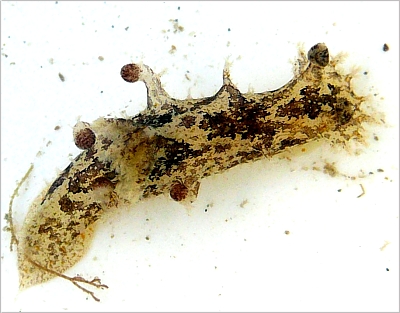
Concerning message #20196:
Hi Bill,
I managed to obtain photos of my previous 'blob' in a much better state. As you suggested, I placed it in a tub of seawater and then photographed it.
It is Plocamopherus ceylonicus and the spheres surround the gills are four light-emitting globes.
Locality: Rowes Bay, Townsville, Low tide 0.27 metres, Queensland, 28 August 2007, Muddy intertidal. Length: 2 cm. Photographer: Melanie Wood.
Thank you to Richard Willan for recognising the species in its blob form and supplying me with the identification and accompanying information above.
Cheers
Mel
melanie.wood@jcu.edu.au
Wood, M.J., 2007 (Aug 29) Re: Cowry? from Townsville, Queensland. [Message in] Sea Slug Forum. Australian Museum, Sydney. Available from http://www.seaslugforum.net/find/20584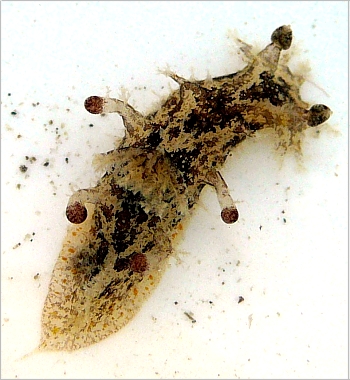
Dear Mel,
Well that was a successful outcome. I am impressed at Richard's ability to identify your animal in blob form - hopefully he will volunteer his opinion on 'unidentifieds' in the future.
As you discovered, the best thing with 'blobs' is to get them into some water so they can crawl and show us their shape and colour. Did you take the animal back to an aquarium to see its light-show? It's not always easy to get them to luminesce but when they do there are often flashes of light from the sides of the body as well as the bulbs. Unfortunately the only times I have been able to witness it have been in the dark so I am not sure if the 'non-bulb' flashes are from the skin or from the small papillae scattered over the body. It's another research project for someone.
Best wishes,
Bill Rudman
Plocamopherus ceylonicus from Western Australia
April 27, 2007
From: Bruce Potter
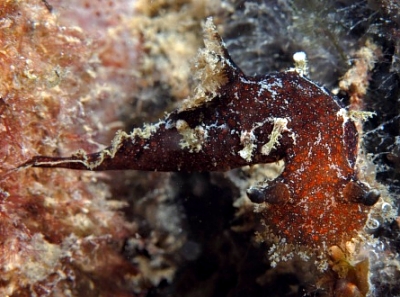
Dear Bill,
I found quite a few of these Plocamopherus ceylonicus on my recent trip to Rockingham. They were out at 18 metres on the sand, and this one was under a jetty in muck. This one would have been about 20 mm and very well camophlaged in the weed on the jetty pylon.
Locality: Rockingham, 7 metres, Western Australia, Indian Ocean, 24 February 2007, Mucky under Jetty. Length: 20 mm. Photographer: Bruce Potter.
Regards
Bruce Potter.
bandppotter@bigpond.com
Potter, B., 2007 (Apr 27) Plocamopherus ceylonicus from Western Australia. [Message in] Sea Slug Forum. Australian Museum, Sydney. Available from http://www.seaslugforum.net/find/19602Thanks Bruce,
This is another example of the dark brown form found in Western Australia
Best wishes,
Bill Rudman
Plocamopherus ceylonicus from Western Australia
February 27, 2007
From: Brent Murdoch

I have not been able to find this one in any of my books. Some type of Plocamopherus?
Locality: Fremantle, Swan River, 3.5 m, Western Australia, Indian, 09 February 2007, Sandy, loose weed. Length: 50 mm. Photographer: Brent Murdoch.
Brent Murdoch
brent@murdoch.id.au
Murdoch, B.D., 2007 (Feb 27) Plocamopherus ceylonicus from Western Australia. [Message in] Sea Slug Forum. Australian Museum, Sydney. Available from http://www.seaslugforum.net/find/19497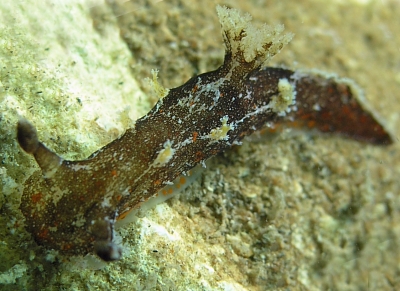
Dear Brent,
I am pretty sure this is a dark form of Plocamopherus ceylonicus. I have just discussed the spheres which are normally found at the tips of some of the four posterior lateral papillae in this species [message #19542]. They seem to be absent in your animal but I can't see the last two papillae clearly enough.
Tantalisingly, there is an earlier message [#18199] from Western Australia of the same species, but again the lateral papillae are out of focus.
Best wishes,
Bill Rudman
Plocamopherus ceylonicus from Singapore
February 27, 2007
From: Toh Chay Hoon
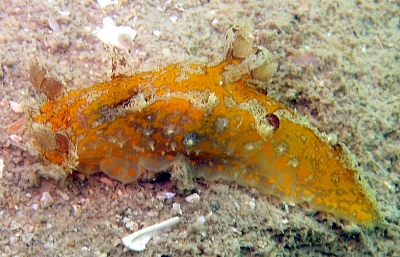
Dear Dr Bill,
I came across this nudibranch during a dive at Singapore Pulau Hantu today.
Here's a few photos attached. Could you kindly help with the ID?
Locality: Pulau Hantu, 5 m, Singapore, South China Sea, 25 February 2007, Coral Reefs, Substrate, Silts. Length: 40 mm. Photographer: Toh Chay Hoon.
Thanks & Regards,
Toh Chay Hoon
sonnenflower@gmail.com
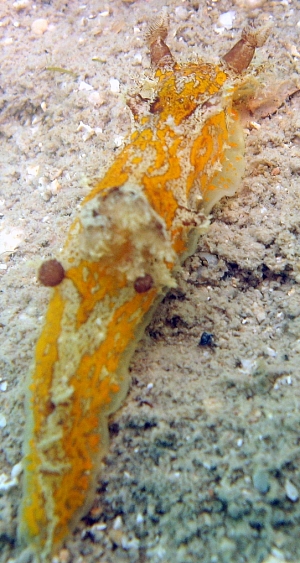

Dear Chay Hoon,
I am pretty sure this is an orange form of Plocamopherus ceylonicus. The background colour in this species seems to be quite variable, ranging from dark brown to translucent whitish and sometimes, as in your animal, the orange-yellow appears not as the normal small spots, but as large patches. There are two fairly consistent colour characteristics of this species and they are the orange spots on the sides of the body and the foot, and the whitish band along the edge of the mantle which behind the gills joins with the equivalent band on the other side and runs down the dorsal midline of the posterior 'tail'. I am pretty sure the animal identified as Plocamopherus cf imperialis by Valles & Gosliner (2006) is a dark brown form of P. ceylonicus. I also suspect that their new species P. pecoso and P. lemur are colour forms as well. They all have the white Y shape behind the gills.
One other interesting feature of your animal is the large brown sphere on each side just behind the gills. As I have mentioned elsewhere in the Forum P. ceylonicus and P. imperialis can produce flashes of light, and these spheres are a major site of this bioluminescence, although flashes of light can occur elsewhere on the sides of the body. Lucas Cervera also reports it in Plocamopherus maderae [message #1286]. It is a fascinating topic but unofrtunately we know little about how it occurs in these nudibranchs. When I saw the catchy title of Valles & Gosliner's paper I thought they were 'shedding light' on this bioluminescence but sadly not. If you look at other photos of P. ceylonicus on the Forum you will find that there can be between one and four of these spheres. I suspect they can be damaged, or nibbled off by fish, but since they are often if different sizes, I also suspect that they can be regrown.
-
Valles, Y. & Gosliner, T. (2006). Shedding Light onto the Genera (Mollusca: Nudibranchia) Kaloplocamus and Plocamopherus with Description of New Species Belonging to These Unique Bioluminescent Dorids. The Veliger 48(3): 178-205.
Best wishes,
Bill Rudman
Re: Plocamopherus tilesii from West Australia
November 6, 2006
From: Samantha Haebich

Concerning message #17926:
Hi Bill,
Apologies for lack of info etc in my earlier message. I was quite lazy with my query largely as I expected you weren't replying any messages at the time and I'd failed to get a response to a previous query. Sorry to have assumed this, I do appreciate your response as I am sure many others value your expertise in this field.
I shall endeavour to improve the quality of my photos although surge was a problem. The location was Robbs Jetty, Fremantle (near Perth, Western Australia) which didn't seem to match the suggested distribution of other sightings. I do recollect it had a long tapering tail though the remainder of my photos (attached) don't capture this.
Keep up the good work and thanks again,
Sam
samhaebich@hotmail.com
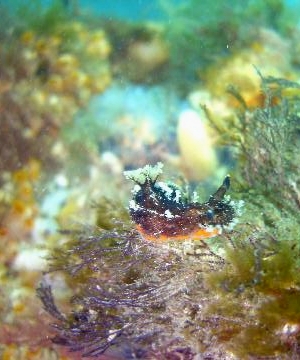
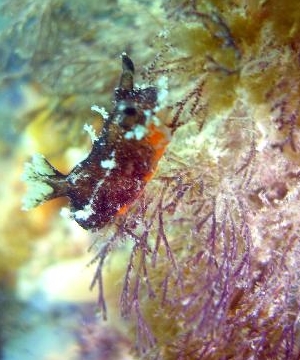
Dear Samantha,
Thanks for the locality information. I realise it is not always easy to photograph these animals but from your comment about the long tapering tail I am pretty sure your animal is Plocamopherus ceylonicus which has a long slender tail like this, I presume for helping it to stay attached to the weedy bryozoans it lives and feeds on. All your photos show it on these sea-weed like bryozoan colonies. Since the colonies thrive in areas with a lot of wave action / water movement, animals living on them are in constant danger of beeing washed off. Another animal, quite unrelated, which has a similar long tail is the sea hare Stylocheilus longicauda.
Plocamopherus tilesii doesn't appear to have an elongate tail, in fact it seems to have a broader foot which may be associated with it living on softer sediments.
Best wishes,
Bill Rudman
Re: Plocamopherus tilesii from Port Stephens, NSW
October 31, 2006
From: Samantha Haebich
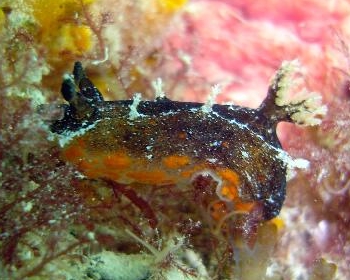
Concerning message #998:
Is this Plocamopherus tilesii also?
Locality: shore jetty dive, 6 m, wa, indian ocean, 24 September 2006, old jetty. Length: 30 mm. Photographer: samantha haebich.
sam
samhaebich@hotmail.com
Haebich, S.J., 2006 (Oct 31) Re: Plocamopherus tilesii from Port Stephens, NSW. [Message in] Sea Slug Forum. Australian Museum, Sydney. Available from http://www.seaslugforum.net/find/17926
Dear Sam,
This could be Plocamopherus tilesii but I suspect it is a dark form of P. ceylonicus. I am afraid your photos don't give me a clear view of either end of the body, both of which have features which could be useful. The papillae around the head end of the mantle are compound in P. tilesii and the keel at the posterior end is quite pronounced.
On a different matter, your message lacked all capital letters, and any useful locality data. I don't want the Forum to descend into the style of text messaging on mobile phones, so I'll use your message as an example to others. Please use capital letters and other normal sentence construction. I don't really want to spend my time doing this sort of editing - every minute I spend doing editing is time I can't spend answering questions
Best wishes,
Bill Rudman
Plocamopherus maculatus from Philippines
September 12, 2005
From: Jeff Rosenfeld
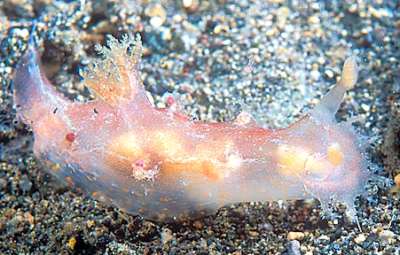
Hi Bill,
Here's a shot of Plocamopherus maculatus taken in Anilao, Luzon Island, Philippines in April, 2002. Apparently, its range also includes the Philippines.
Locality: Anilao, Luzon Island, Philippines. Depth: 30 ft. Length: 3 cm. April, 2002. Photographer: Jeff Rosenfeld
Thanks,
Jeff
http://www.vibrantsea.net
jeff@rosenfeldfamily.net
Rosenfeld, Jeff, 2005 (Sep 12) Plocamopherus maculatus from Philippines. [Message in] Sea Slug Forum. Australian Museum, Sydney. Available from http://www.seaslugforum.net/find/14688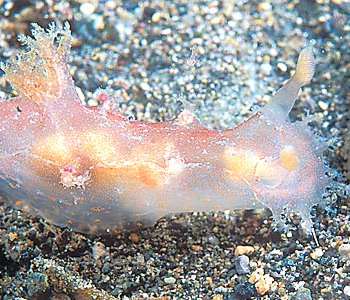
Dear Jeff,
From the yellow spots around the edge of the foot, and general shape, I suspect this is a pale form of Plocamopherus ceylonicus. It also has 3 pairs of lateral papillae while P. maculatus seems to have only two.
Best wishes,
Bill Rudman
Plocamopherus ceylonicus from northern NSW
July 23, 2004
From: Denis Riek

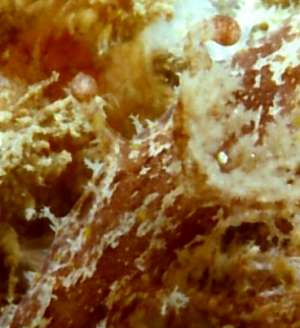
Dear Bill,
Here are two shots of Plocamopherus ceylonicus from the Brunswick River, nthn New South Wales, taken in February 2003. The upper photo is a form I have seen on several occasions and except for this one have all been very small juveniles. Both these animals were approx 25mm and were found in 3-4 metres on internal walls.
The lower photo is the typical colour variety here and shows how well it blends into its surroundings.
Regards,
Denis Riek.
denisriek@hotmail.com
Riek, D., 2004 (Jul 23) Plocamopherus ceylonicus from northern NSW. [Message in] Sea Slug Forum. Australian Museum, Sydney. Available from http://www.seaslugforum.net/find/12515Thanks Denis,
I've just included a closeup of part of your 'typical' colour form because if I had reduced the whole photo in size the animal would have been invisible. I'm afraid it's one of the problems with photographing 'camouflage' - If you take a good photo you can't see the object!
In the closeup you can see two of the brownish ball-shaped knobs on the end of the lateral papillae. These are one of the main sources of luminescence when the animal is agitated
Best wishes
Bill Rudman
Hong Kong Plocamopherus ceylonicus
March 11, 2002
From: W.B. Rudman & B.W. Darvell

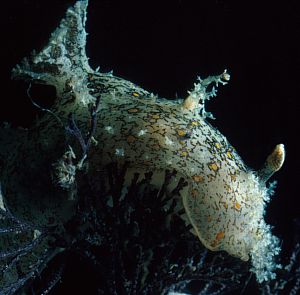
Here is some information and photos on Plocamopherus ceylonicus from Brian Darvell's Hong Kong collections.
The mantle is reduced to a head shield or veil around the anterior end and a set of three large papillae down each side of the body. There are about twelve arborescent papillae on the edge of the head shield and some or all of the large lateral papillae can have a large terminal sphere which can luminesce when the animal is disturbed. There are also scattered arborescent papillae on the sides of the body and the posterior end of the foot has a large crest in the dorsal midline.
Specimens from Hong Kong are a translucent white with a dark grey-brown irregular reticulate pattern and yellow spots. In Australia and the Indian Ocean the yellow spots become less prominent and the dark reticulate pattern becomes a heavy patching of brown or orange-brown.
Like other species of the genus, P. ceylonicus feeds on bryozoans and can swim when disturbed or dislodged by flattening its body dorso-ventrally and vigorously bending its body backwards and forwards laterally. It grows to approximately 45 mm in length.
PHOTO:
AM C139085, 2 specimens, 8 April 1983, Site 5.51, Heung Lo Po, Tolo Channel (Gruff Head), 5-10 m, Hong Kong. Photo: Brian Darvell.
Hong Kong Collection Records:
AM C139085, 2 specimens, 8 April 1983, Site 5.51, Heung Lo Po, Tolo Channel (Gruff Head), 5-10 m. AM C139086, 8 April 1983, Site 5.51, Heung Lo Po, Tolo Channel (Gruff Head), 5-10 m. AM C139087, 3 specimens, 11 April 1983, Site 4.60, Kong Chan (NW), Mirs Bay, 5-10 m. AM C139088, 2 specimens, 12 April 1983, Site 6.62, Flat Reef, Tolo Channel, 7-12 m. AM C139089, 5 specimens, 14 April 1983, Site 2.32, Round Is. (E), Mirs Bay, 3-10 m. AM C140154, 2 specimens, 8 May 1983, Site 2.66, Round Is. (W), Mirs Bay, 4-6 m. AM C140164, [not known]. AM C 1423 35, 1 0 June 1984, Site 9.108, Chi Chau (NW), Rocky Harbour, I m. AM C146972, 10 specimens, 5 May 1985, Site 9.159, 'Dolphin Reef', Rocky Harbour, I m. AM C149774, 19 October 1985, Site 10. 168, Kiu Tsui Chau (W of Tai Ngam Tsui), Port Shelter, 6 m. Depth range: 1-12 m.
Reference:
• Rudman, W.B. & Darvell, B.W. (1990) Opisthobranch molluscs of Hong Kong. Part 1. Goniodorididae, Onchidorididae, Triophidae, Gymnodorididae, Chromodorididae, (Nudibranchia). Asian Marine Biology, 7: 31-79
Best wishes,
Bill Rudman & Brian Darvell
Plocamopherus ceylonicus from the Marshalls
March 29, 2000
From: Scott Johnson
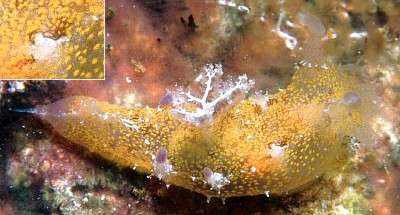
Hi Bill,
Attached is a scan of what I've been calling Plocamopherus ceylonicus from the Marshalls. The dozen or so specimens I've seen ranged in length from 6 to about 27mm, and all were similar in coloration to this one. The scan has poor contrast on the anterior end of the animal, but the rest of the body appears to have much more dense orange spotting and much less brown pigment than the animals from Australia and Sulawesi. My color notes do refer to brown speckling aggregating into small brown patches, but that is not very visible in the photo.
Scott
johnson@kmr.ll.mit.edu
Johnson, S., 2000 (Mar 29) Plocamopherus ceylonicus from the Marshalls. [Message in] Sea Slug Forum. Australian Museum, Sydney. Available from http://www.seaslugforum.net/find/2170
Dear Scott,
Your animals have certainly emphasised the yellow spots but in shape they certainly look very similar. Out of interest I've added a copy of Kelaart's original drawings, [which are in the Natural History Museum, London] which were later annotated by Charles Eliot for his 1906, 1907 publications on Kelaart's material from Ceylon.
Kelaart described his Polycera? zeylanica as: "Colour above bright orange-red, beneath whitish, with red specks seen through the transparent foot" and when swimming .. " moving its body like an eel in the water"
In all specimens I have seen the red specks are orange or yellow. I have posted in a separate message unpublished drawings/paintings of this species in Wlater Elliot's collections from India, written up by Alder & Hancock (1864).
Best wishes,
Bill Rudman.
Plocamopherus ceylonicus - early paintings
March 29, 2000
From: Bill Rudman
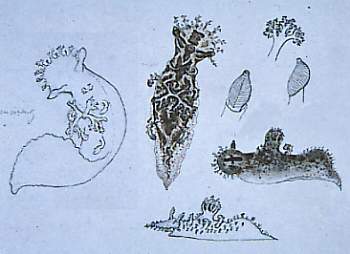
To accompany the discussion on Plocamopherus ceylonicus I thought it would be interesting to show you these photos of some old paintings I found some years ago in the Natural History Museum, London. When Alder & Hancock (1864) published their paper on Indian nudibranchs, it was based on specimens collected by Walter Elliot and paintings that Elliot had done by local Indian artists. They show variations in colour but in all cases the orange yellow spots are visible on the edge of the foot.
UPPER RIGHT: Waltair, India 18 March 1854
LOWER LEFT: Waltair, India 21 March 1854
Lower RIGHT: No details.
In the upper right picture there is an excellent drawing of an animal swimming. Note how the posterior end of the foot has expanded into a high 'blade' which in concert with the lateral flexion of the body, acts as a paddle to propel the slug during swimming.
Best wishes,
Bill Rudman.

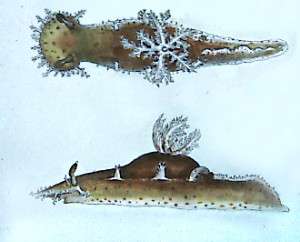
Plocamopherus ceylonicus from Sulawesi
March 28, 2000
From: Lindsay Warren
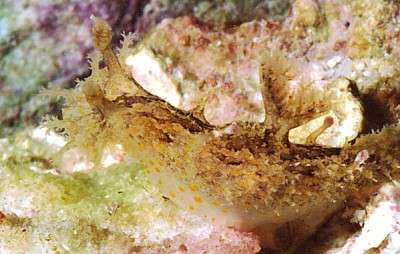

Dear Bill
The first of these specimens was found by David Moss at 9pm on 6 September 1999 floating in mid water at a depth of 1 m over sea grass, Halimeda and sand flats of Pulau Kaledupa [Tukang Besi Archipelago, SE Sulawesi, Indonesia - Operation Wallacea]. Sizes: 18-24 mm.
The body is mottled white, dark and light brown, white towards the foot which also carries orange spots. The anterior end has branched papillae and on either side of the body are two longer curled extensions with 'globes' at the end. In some specimens these are pink but not in all cases. Over the body are short papillae while down the upper centre of the tail behind the branchial plume is a more pronounced ridge of papillae. The rhinophores are retractile with a club at the end of a relatively long stem. When it moves, the body waves from side to side as if it were sauntering along with a swagger. One specimen laid a pink beige egg mass in a holding dish. Photos: Lindsay Warren.
Looking forward to hearing what you think it might be.
All the best
Lindsay Warren
100014.2112@compuserve.com
Warren, L., 2000 (Mar 28) Plocamopherus ceylonicus from Sulawesi. [Message in] Sea Slug Forum. Australian Museum, Sydney. Available from http://www.seaslugforum.net/find/2159Dear Lindsay,
This is Plocamopherus ceylonicus one of this fascinating genus which has the light-producing 'balls' down each side of its body. When they swim they erect the 'tail' into a flattened vertical plane and throw the body into lateral waves, like a fish. Your first photo arrived scrambled. I'll post it when you get a chance to send me another copy.
Best wishes,
Bill Rudman.
